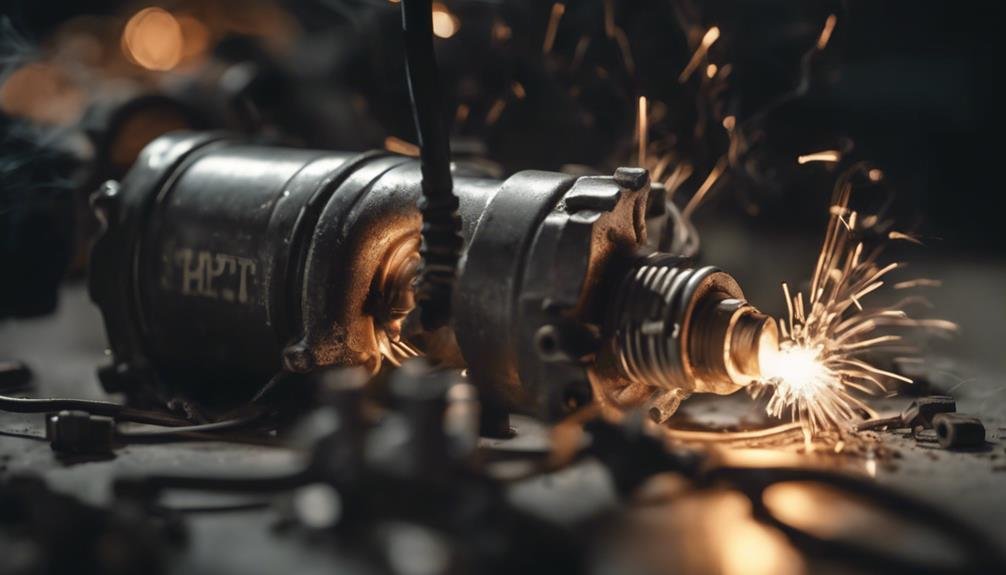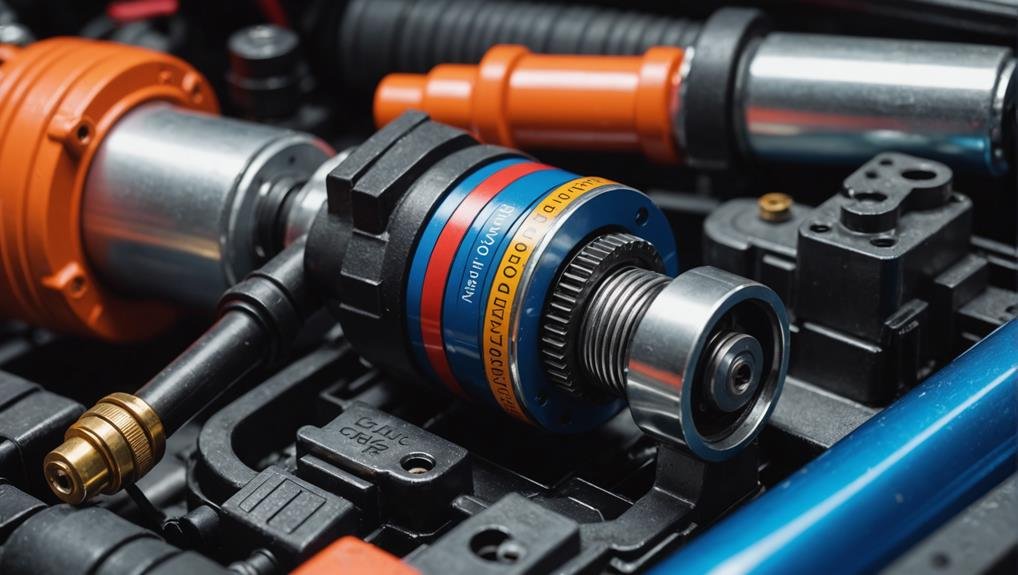As you investigate the inner workings of small engines, you'll likely encounter the magneto ignition system, a self-contained unit that generates high-voltage pulses for ignition without relying on a battery. The magneto uses electromagnetic induction to produce current in coils, with a permanent magnet inducing a magnetic field in the armature. The primary coil is connected to the secondary coil, which produces high-voltage pulses for spark plug ignition. Control units regulate the timing of current flow for precise ignition. With its compact, lightweight design, the magneto ignition system is a reliable and efficient choice for small engines, and as you continue, you'll learn more about its advantages and common causes of failure.
Key Takeaways
- A magneto ignition system generates power for spark plugs without a battery, using electromagnetic induction to create high-voltage pulses.
- The system consists of primary and secondary coils, with the primary coil connected to the secondary coil to produce high-voltage sparks.
- A permanent magnet induces a magnetic field in the armature, which then induces a current in the coils.
- A control unit regulates the timing of the current flow to ensure precise ignition in small engines.
- The magneto functions independently without an external power source, making it ideal for applications like aircraft engines.
Understanding Magneto Ignition Systems
When you investigate the world of magneto ignition systems, it's vital to understand the fundamental concept that these systems generate power for spark plugs without relying on a battery.
This self-contained unit is basically an electrical generator tuned to produce high-voltage pulses for ignition. At the core of the magneto ignition system lies the primary and secondary coils, which work in tandem to generate the high voltage sparks, around 20,000 volts, necessary for ignition.
This precise timing is crucial for efficient combustion in small engines, commonly found in lawn mowers, chain saws, and even airplanes. The magneto's ability to produce high-voltage sparks at the exact moment ensures efficient engine performance.
As you delve deeper into the world of magneto ignition systems, it's important to grasp the intricate workings of these systems, which have been perfected over the years to provide reliable ignition in a variety of applications.
How Magnetos Generate Electrical Current
As you investigate the inner workings of a magneto, you'll realize that it generates electrical current through the process of electromagnetic induction, where the movement of magnets induces a magnetic field in the armature, creating current in the coils.
This process is made possible by the permanent magnets, which rotate to induce a magnetic field in the armature, generating electrical current in the primary coil. The primary coil is connected to a secondary coil, where the current is amplified to produce high-voltage pulses for the spark plugs.
The control units in the magneto regulate the timing of the current flow, ensuring precise ignition. The self-contained nature of magnetos makes them reliable for providing spark plug power without the need for an external power source like a battery.
As you delve deeper, you'll understand that the magnetic field created by the permanent magnets is the key to generating electrical current in the coils, making the magneto a crucial component of the ignition system.
Key Components of a Magneto

You'll find that a magneto consists of several vital components, including an armature shaped like a capital U, primary and secondary coils, an electronic control unit, and a pair of strong permanent magnets in the flywheel.
The U-shaped armature serves as the foundation for inducing current in the primary and secondary coils, leading to the generation of high-voltage sparks. The primary coil has around 200 turns, while the secondary coil has approximately 20,000 turns.
The electronic control unit, which can be electronic or traditional breaker points and capacitor, plays a pivotal role in timing the spark generation process. The pair of permanent magnets in the flywheel create the magnetic field necessary for the magneto to function, making them a fundamental element of the ignition system.
The breaker points, if used, work in conjunction with the capacitor to regulate the spark timing. With these components working in harmony, the magneto is able to generate the high-voltage sparks needed to ignite the fuel in your engine, making it a critical component of your vehicle's ignition system.
Advantages of Magneto Ignition Systems
Magneto ignition systems boast a reputation for delivering sparks consistently, without relying on an external power source, making them a dependable choice for a range of applications. You'll often find them in aircraft engines, where their independence from batteries and consistent spark generation are essential.
As a compact and relatively lightweight ignition system, magnetos are ideal for applications where external power sources may not be reliable. Modern versions have been constructed using lighter materials, enhancing their efficiency and performance. The aircraft magneto, in particular, is designed to provide a high voltage spike to spark plugs, ensuring a reliable ignition source. This is achieved through the primary coil, impulse coupling, and permanent magnet, which work together to generate a spark.
With no risk of electrical failure, magneto ignition systems provide a reliable alternative to traditional ignition systems. Their reliability, compact design, and independence from external power sources make them an attractive choice for a range of applications, particularly in aircraft engines where engine failure could have serious consequences.
Common Causes of Magneto Failure

Corrosion, wear, and tear can cause your magneto to fail, and understanding the common causes of failure is important to preventing these issues.
One common cause is engine oil or fluid entering the magneto system, which can lead to failure. If the oil seals deteriorate, they can leak into the system, causing damage.
Moreover, arcing at the set of breaker points can cause erosion, affecting the magnetic field stability. This erosion can result in an unstable magnetic field collapse, which leads to a smaller voltage spike, ultimately affecting spark plug performance.
When the armature reaches its maximum, it causes a voltage spike in the primary coil, which induces an electric current in the secondary coil. However, if the magnetic field is unstable, it can disrupt the flow of current, leading to failure.
It's important to maintain your magneto system to prevent these common causes of failure. By understanding how the iron core and coils interact, you can take steps to prevent corrosion, wear, and tear from causing your magneto to fail.
Maintenance and Overhaul Procedures
As part of routine maintenance, it is essential to follow recommended intervals, typically every 500 hours, to guarantee your aircraft magneto system operates at peak performance. This secures that the magneto, which consists of five main components, functions efficiently. During maintenance, you'll inspect the coil of wire, primary current, and field in the armature to identify any issues. A rotating magnet, mechanical linkage, and permanent iron bar work together to amplify this voltage, ultimately igniting the fuel.
| Procedure | Description |
|---|---|
| Regular Maintenance | Inspect and clean the magneto, check timing and voltage output |
| Overhaul | Disassemble, inspect, and replace worn or damaged parts |
| Factory Overhaul | Bring the magneto up to new standards, specified by the manufacturer |
| Timing and Efficiency Testing | Optimize ignition and fuel efficiency in aircraft engines |
| Component Replacement | Replace worn or damaged parts to maintain efficiency and reliability |
Frequently Asked Questions
How Does the Magneto Ignition System Work?
You're wondering how the magneto ignition system works? Well, it's simple: magnets induce a magnetic field, generating current in primary and secondary coils, which produces high-voltage pulses for spark plugs, regulating timing through breaker points or electronic components.
How Does a Magneto Flywheel Work?
You're curious about how a magneto flywheel functions? Basically, it's a rotor with powerful permanent magnets that create a magnetic field as it rotates, causing voltage in nearby coils, ultimately igniting your engine to start.
How Do You Test a Magneto Ignition?
You'll test a magneto ignition by grounding the spark plug against the engine, using a spark plug tester or gap tester, and checking for a bright blue spark and proper voltage output with a multimeter.
How Many Volts Does a Magneto Put Out?
You're wondering how many volts a magneto puts out – well, typically, it produces around 20,000 volts of electricity for the spark plugs, which is crucial for creating a strong spark to ignite the fuel-air mixture in the engine.
Conclusion
Now that you've explored the world of magneto ignition systems, you're equipped to understand the inner workings of these complex components.
With a grasp on how magnetos generate electrical current and the key components involved, you can better appreciate the advantages they bring to the table.
By recognizing common causes of failure and staying on top of maintenance, you'll be well-versed in keeping your magneto running smoothly.
